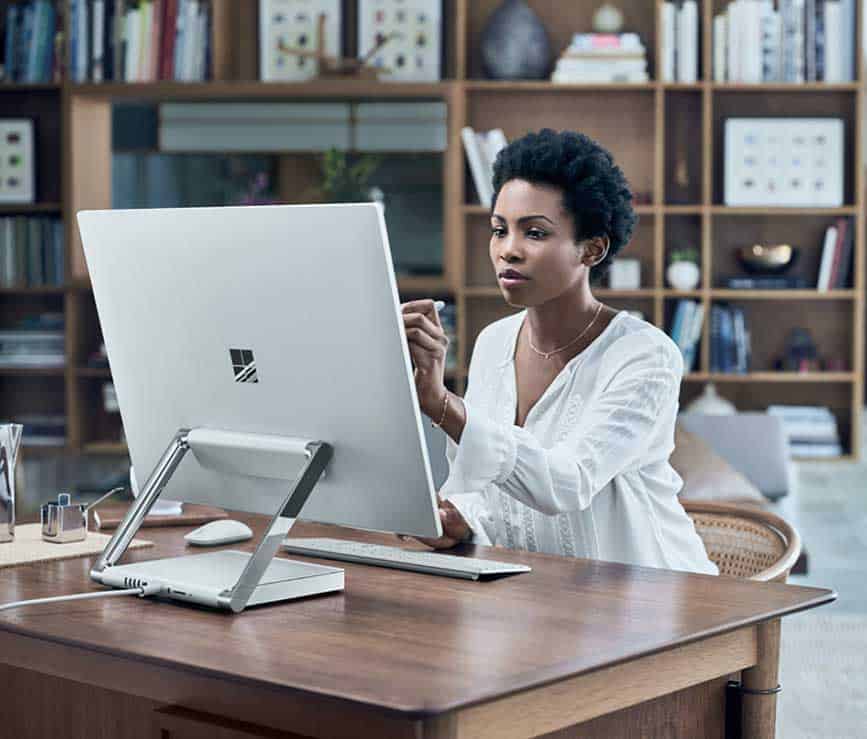
Above: Microsoft’s new Surface Studio folds almost flat on a desk with the touch of a hand. Photo courtesy Microsoft.
BitDepth#1065 for November 01, 2016
Microsoft deserved better last week. The company launched two bold, newsworthy products in the Surface Pro 4 and the Surface Studio and got swamped by, of all things, an OLED strip half an inch wide and less than a foot long.
That this happened speaks to some fundamental differences between the Microsoft and Apple of 2016 and the expectations that consumers and the media have of both companies.
Apple introduced a long overdue MacBook Pro with a new color option, upgraded specifications and the Touch Bar, an OLED strip that replaces the row of F keys at the top of the keyboard.
It’s a clever idea and the fact that it’s based on the technology the company developed for the Apple Watch may offer interesting synergies and developer possibilities in the future.
I’m a MacBook Pro user with a four-year-old device and will probably consider that upgrade next year after it’s been in production for a while, but nothing the company announced last week has me desperate to own a new MacBook.
The Surface Pro 4, however, is Microsoft’s professional tablet, the latest in a line that debuted in 2012 offering an interesting take on the idea of a touchscreen device that could run a full-fledged desktop OS.
Unfortunately that OS was Windows 8, a self-inflicted kneecapping that Microsoft has been working for most of the years since to recover from.
In October 2015, Microsoft introduced the Surface Book, a direct shot across the bow of Apple’s MacBook Pro series and the new Surface Pro 4 takes on the iPad Pro.
But the Surface Studio stakes out some interesting new territory.
It’s a desktop computer with a massive 28 inch display that tilts all the way down to an angle of roughly 15 degrees to a table. It’s a touchscreen, so in that configuration, it looks more like a draughtsman’s table than a computer and you can touch or draw directly on it.
It’s unclear whether the Surface Studio will ever pose a direct threat to a device like the Wacom Cintiq, a dedicated artist’s digital drawing monitor, but it may never have to be something like that.
Microsoft is gambling that the comfort that users have working with a touchscreen device is scalable and will work all the way out to a screen that will command the typical desk.
That makes the company’s decision to introduce a third input peripheral on the Surface Studio puzzling. You can add a metallic puck called the Surface Dial to the desktop device and interesting and colourful options appear for selection.
Most professional users are already comfortable doing that with a mouse or keyboard, which both work with the new desktop, so it’s unclear whether there will be enough user demand for a fourth input option on a touchscreen device will gain traction with users or with the programmers who have to make the pretty stuff happen.
The other thing that’s standing in the way of more success for these new Surface innovations is Microsoft itself.
The company has spent its time wisely innovating in professional tablets, laptops and now a desktop that essentially has no competition in the market, but Microsoft has an annoying habit of being coy with its customers to please its hardware partners.
The Surface series of devices, for instance, has never been officially available in Trinidad and Tobago and have been spottily introduced in Latin America.
Even as the company’s smartphone business sputters out and dies and it invests in what is essentially a mindshare comeback in the computing space, the company has sent no signals that it intends to be a serious player as a vendor of innovative hardware.
To do that, it must be willing to ship both aggressively and everywhere and stop hiding behind the “reference hardware” cop-out it uses to mollify its hardware partners.
The company is talking a big game with these new devices (the Surface Studio intro video alone is a thing of tech porn), now it must back it up with the kind of market presence and global reach it normally reserves for software releases.


